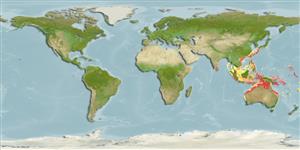>
Carangiformes (Jacks) >
Carangidae (Jacks and pompanos) > Caranginae
Etymology: Alepes: Greek, alepis, -idos = without scales (Ref. 45335).
Environment: milieu / climate zone / depth range / distribution range
экология
морской демерсальный; пределы глубины 5 - 80 m (Ref. 86942). Tropical
Western Central Pacific: endemic to northern Australia, from Exmouth Gulf, Western Australia to Wide Bay, Queensland.
Size / Вес / Возраст
Maturity: Lm ? range ? - ? cm
Max length : 29.5 cm TL самец/пол неопределен; (Ref. 9894)
колючие лучи спинного плавника (общее число): 8; членистые (мягкие) лучи спинного плавника (общее число): 24-26; колючие лучи анального плавника 3; членистые (мягкие) лучи анального плавника: 20 - 22; позвонки: 24. This species is distinguished by the following characters: adipose eyelid well developed on posterior half of the eye only; upper jaw narrowly rounded posteriorly, with supramaxilla relatively small without an anterior spine-like extension; gill rakers (including rudiments) 8-10 + 18-21 = 27-30. Colour in life green to bluish green above, silvery to white below, a diffuse dusky blotch on margin of opercle, not bordered above by a white spot; interradial membranes of spinous dorsal fin hyaline to dusky; spinous and second dorsal, anal, and caudal fins dusky yellow, with anterior rays of second dorsal and anal fins often with white tips; caudal-fin lobes often with dark tips; pelvic fins white and pectoral fins hyaline; juveniles with 7 dark bands on body (Ref. 9894).
Adults occur in inshore waters of the continental shelf (Ref. 75154). Feeds primarily on small invertebrates, primarily microscopic crustaceans and molluscs. Caught mainly on hook-and-line (Ref. 9894).
Life cycle and mating behavior
половая зрелость | размножение | нерест | икра | Fecundity | личинки
Smith-Vaniz, W.F., 1999. Carangidae. Jacks and scads (also trevallies, queenfishes, runners, amberjacks, pilotfishes, pampanos, etc.). p. 2659-2756. In K.E. Carpenter and V.H. Niem (eds.) FAO species identification guide for fishery purposes. The living marine resources of the Western Central Pacific. Vol. 4. Bony fishes part 2 (Mugilidae to Carangidae). Rome, FAO. 2069-2790 p. (Ref. 9894)
Статус Красного Списка МСОП (Ref. 130435)
Угроза для людей
Harmless
Использование человеком
рыболовство: коммерческий
дополнительная информация
народные названиясинонимыобмен веществхищникиэкотоксикологияразмножениеполовая зрелостьнерестSpawning aggregationFecundityикраРазвитие икры
Возраст/РазмерыростЗависимость между длиной и массой телаЗависимость между длинамиРазмерный составморфометрияморфологияличинкидинамика численности личинокпополнениечисленностьBRUVS
ссылкиаквакультура (рыбоводство)особенности рыбоводствастепень растяжениягенетикаElectrophoresesнаследуемостьболезниобработкаNutrientsMass conversion
соавторыизображенияStamps, Coins Misc.звукиCiguateraскоростьтип плаванияжаберная областьOtolithsмозгзрение
инструменты
Специальные отчеты
Скачать в формате XML
ресурсы в Интернет
Estimates based on models
Preferred temperature (Ref.
123201): 24.5 - 28.7, mean 27.7 °C (based on 544 cells).
Phylogenetic diversity index (Ref.
82804): PD
50 = 0.5312 [Uniqueness, from 0.5 = low to 2.0 = high].
Bayesian length-weight: a=0.01349 (0.00646 - 0.02815), b=2.96 (2.79 - 3.13), in cm total length, based on LWR estimates for this (Sub)family-body shape (Ref.
93245).
Trophic level (Ref.
69278): 3.5 ±0.5 se; based on size and trophs of closest relatives
устойчивость к внешним воздействиям (Ref.
120179): высокий, минимальное время удвоения популяции до 15 месяцев (Preliminary K or Fecundity.).
Fishing Vulnerability (Ref.
59153): Low vulnerability (20 of 100).
